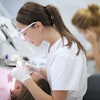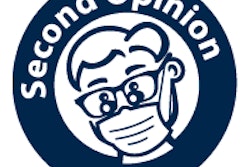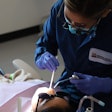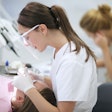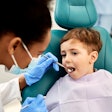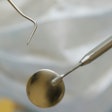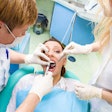
Dental therapists are successfully integrating into Minnesota practices with myriad advantages, according to a preliminary report issued to the state Legislature. The report noted less dependence on emergency rooms, while practices with them on staff have enjoyed greater dental team productivity, personnel cost savings, and improved patient satisfaction.
"The dental therapy workforce is growing and appears to be fulfilling statutory intent by serving predominantly low-income, uninsured, and underserved patients," noted the report, produced by the Minnesota Department of Health and the Minnesota Board of Dentistry.
However, its findings have been disputed by the Minnesota Dental Association (MDA). "We're in support of the dental therapists working as part of the dental team," MDA President Michael Perpich, DDS, said during an interview with DrBicuspid.com. "But with only 26 dental therapists practicing among a workforce of 17,000, it's too early to tell if they are having an impact."
“It's too early to tell if they are having an impact.”
Minnesota Dental Association
Representatives for the two organizations that produced the report acknowledged that the model is just getting started. "It appears, from a preliminary study, that dental therapists are improving access to care, especially for low-income Minnesotans," Marshall Shragg, executive director for the Minnesota Board of Dentistry, said during an interview with DrBicuspid.com. "And they provided quality care. From these responses, once a dental therapist is integrated into the practice, they tend to increase team productivity, satisfaction, and save costs."
Mark Schoenbaum, director of the Office of Rural Health and Primary Care at the health department, called the report a "preliminary snapshot" during an interview with DrBicuspid.com and had similar thoughts as Shragg about the report's findings. "Although the dental therapist [model] is in its infancy, it does find promising signs that they are improving access, especially for low-income Minnesotans, while providing safe, quality care," he said.
The report was a requirement of the legislation, passed in 2009, that made Minnesota one of the first U.S. states to approve dental therapists and advanced dental therapists, who have a master's degree in dental therapy and 2,000 hours of clinical practice. Shragg described the process as "a recognition that worldwide, there are different workforce models."
"With the primary goal of trying to incrementally address access issues for underserved populations, addressing workforce issues could be one of the approaches," he added.
While his organization has embraced its role in carefully regulating dental therapist licensing and education, the Board of Dentistry kept its distance as the legislative process unfolded. "When the dust settled, there were some options put forth that were different than anybody anticipated but could be worked with," Shragg explained.
The report tracked the progress of 15 clinics that are located in a range of environments, from urban to rural. The researchers surveyed 1,382 dental therapist patients, sought the opinions of the staff at the clinics where these clinicians were employed, and gathered clinic administrative data, licensing data, and oral health-related emergency room data.
By early February 2014, 32 licensed dental therapists were practicing in the state and six had advanced dental therapist certifications. These clinicians treated 6,338 new patients, 84% of whom were enrolled in public programs. Nearly one-third of the patients surveyed experienced a reduction in drive times and wait times for an appointment -- the effect was greater in rural areas, the report authors explained.
Dr. Perpich did not dispute the quality of care provided by dental therapists, but he felt that other claims did not add up. "Patients have to drive the same distance to see the dentist or the dental therapist since they work in the same building," he said. "I currently work in a clinic that has two of them, and there haven't been any reports of patient satisfaction for the care provided by the dental therapists as compared to the dentists."
Just who was saving money with the dental therapist model? Dr. Perpich disagreed with the report's claims on this front as well. "Patients charged $100 for a procedure are going to pay the same whether it's performed by a dental therapist or a dentist," he said. "The person that employs the dentist or the dental therapist, there's a fee that he saves, because he pays the dental therapist less than the dentist. But the patient or the plan pays the same out of pocket no matter what provider he or she sees."
The savings from the lower cost of employing dental therapists could enable clinics to increase their capacity for public program and underserved patients, according to the report. "With identical state public program reimbursement rates for dentist and dental therapist services, there is not necessarily an immediate savings to the state on each claim paid; however, the differential between department of human services (DHS) rates and clinics' lower personnel costs for dental therapists appears to be contributing to more patients being seen," the report noted.
Dr. Perpich allowed that productivity may increase in some areas, but that the potential is limited. "It has increased the productivity of the team because the therapist can do fillings, but it doesn't help with more complex things," he said.
The report broke down the hours worked by dental therapists as well, noting a range of one to 36 hours per week for a total of seven full-time equivalents (FTEs). "It would be unrealistic to suggest that the experiences of seven FTEs can determine trends for an entire healthcare profession in the state of Minnesota," Dr. Perpich stated.
He acknowledged progress in the model, however. "The way they're being utilized has been correct -- as part of a team," he said. "But without the team around them, the dental therapist cannot be successful."
Legislators began to see the report at the end of February, and, currently, there are no plans in place for another. But the Department of Health, Board of Dentistry, and the Minnesota Dental Association agree that more data are needed.



